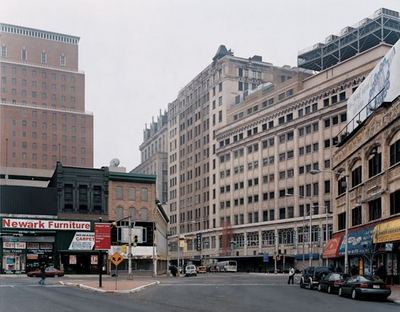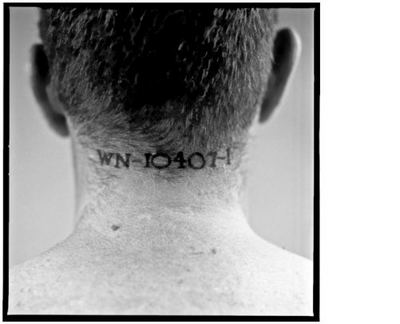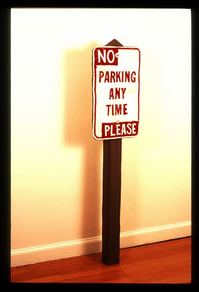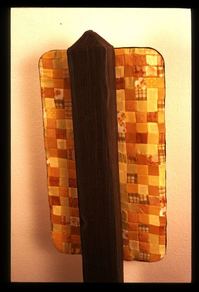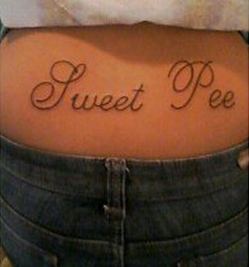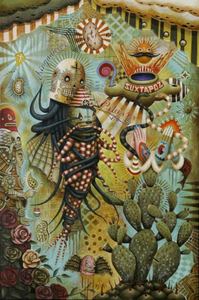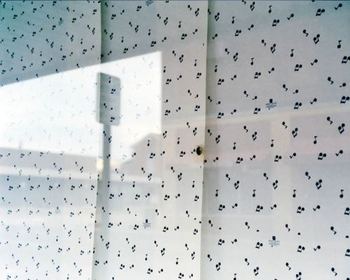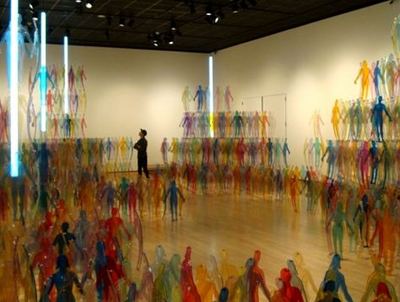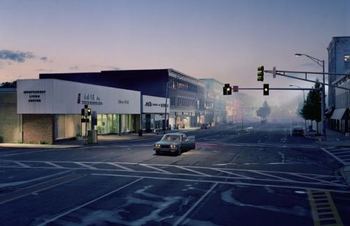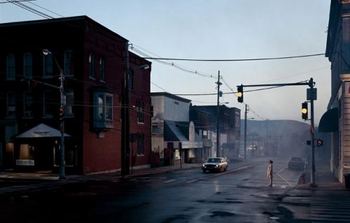James L. Acord – his (nuclear) tattoo
In a recent post titled, James L. Acord – the transformation of nuclear waste, I referred to his tattoo, which marked a big step forward for his effort to turn nuclear waste into sculpture.
In 1993, after endless negotiations with the Department of Energy, Acord became the only individual on the planet licensed to “own and possess” nuclear material. To mark his triumph, he had the license number tattooed on the back of his neck.
I didn’t have an image of that tattoo. Now, thanks to Arthur S. Aubry, who took the photo sent via Howard House, I do.
Paul Margolis (artist & bus driver) – polite street sign
Paul Margolis – the absolutely true story of the artist on the bus
Paul Margolis and his (then) girl friend Mandy Greer were lively presences in the Seattle art scene in the 1990s.
I remember them as exceptionally snappy dressers.
(Below, Fashion is Love, 2003)
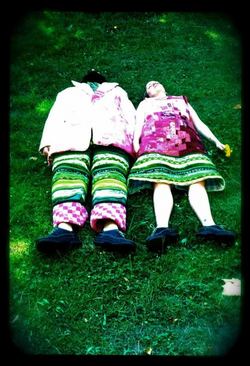 Since marriage and the birth of their son, Hazel, now four, Greer is the only one whose profile remained high.
Since marriage and the birth of their son, Hazel, now four, Greer is the only one whose profile remained high.
Margolis put his career on hold to concentrate on bringing home the bacon, raising Hazel and helping his wife with her various (always fascinating) projects.
Breathes there a feminist who isn’t charmed by this tale? I’m sold, with the reservation that a two-artist couple is most feminist when partners find a way for both to prosper, which is what’s happening now.
Margolis is back. (His blog here.) What he makes relates to his experiences as city bus driver, dad and husband.
1. Stand-up partner. Even on a diagonal (Stud), he can be counted on.
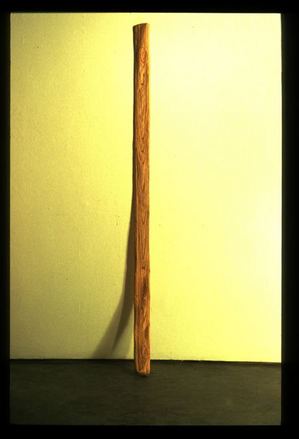 2. Dad. Below, he shows Hazel how to be a Vitruvious Man.
2. Dad. Below, he shows Hazel how to be a Vitruvious Man.
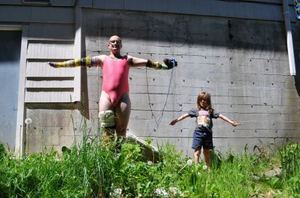
Do It Yourself. (Right Fingers) Teaching Hazel to work with his hands.
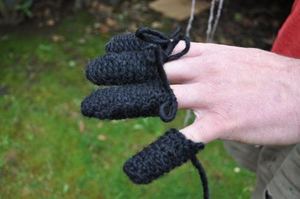 Nuturing. (Yarn Tree 5) Hazel sees that men can caretake.
Nuturing. (Yarn Tree 5) Hazel sees that men can caretake.
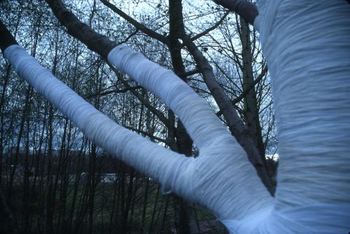 3. As a bus driver, Margolis obeys all street signs (here and here) and has the back of meter maids.
3. As a bus driver, Margolis obeys all street signs (here and here) and has the back of meter maids.
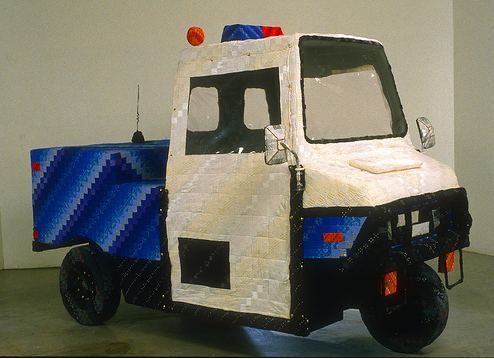 I Dreamed I Was A Meter Maid is now on view in the lobby of the Bellevue Arts Museum. Margolis talks about his work tonight at the museum. (Sorry for late notice.)
I Dreamed I Was A Meter Maid is now on view in the lobby of the Bellevue Arts Museum. Margolis talks about his work tonight at the museum. (Sorry for late notice.)
Speaking of his lecture, BAM’s promo belongs on FAIL Blog:
Free First Friday Lecture Series: Paul Margolis:
Quilting and fiber artist Paul Margolis works with unique materials such as vinyl and lace. His piece I Imagined I was a Meter Maid is featured in Bellevue Arts Museum’s Forum. Join him for a lively talk about this creative and quirky work of art as well new ideas and past pieces.
6:30 – 7:30 pm
FREE for members/$5 non-members.
Hello BAM: Free First Friday? Even in Bellevue, $5 isn’t free.
New jobs for copy editors
The ins and outs of art openings – you can die out there and be another accident statistic
Whenever I determine not to read (or write) another top ten list, Glasstire: Texas Visual Art Online publishes one more great one. Beneath the absurdity of Beth Secor’s 10 tips for navigating the Ins and Outs of Openings is bedrock good sense.
Take Secor’s #6, Location, Location, Location. Last night at Heide Hinrichs and Debra Baxter’s opening at Howard House (more later), I found myself talking to a woman who wants to open a gallery in Post Alley (Pike Place Market.)
“Nobody will come,” I told her. “There’s no place to park and nothing that amounts to any kind of art density already in place.” Yes, in a better world, we’d all hoof it far and wide. Neither rain nor sleet nor hail nor snow and so forth. In this world, to misquote Bob Dylan, the dealer will die out there and be another accident statistic.
Or, as Secor put it:
6. Location, Location, Location.
Think twice about the gallery you have chosen. Is it off the beaten path, perhaps in a sewage pipe or demolished building? Is it easily accessible? (For example, does it have a door, or do you have to crawl through a window?) Is it surrounded by barbed wire? Once a patron enters, is he ever heard from again? Is the gallery owner reputable or does he have a name like Louie the Lip?
The dealer doesn’t have to stress his lip to be unreliable. Call it the kick the dog theory. A guy has a bad day at the office, comes homes and yells at his partner. His partner yells at the kid who kick the dog who defecates in the shoe of the guy who had a bad day at the office.
In a bad economy, dealers struggling to stay afloat too frequently fail to pay artists in a timely fashion if at all, thinking as dealers they need the money to make frayed ends meet. (Isn’t this the reasoning of bank robbers?)
It’s the untold story. I keep hearing it, always with a don’t-tell caveat. If desperate, artists might yell at the kid, but they protect the dealer till there’s absolutely no reason to do so. That’s why it’s important to have a dealer who doesn’t think of artists’ money as back-up stash.
Secor’s # 7 is titled, What Should I Serve? Is this a regional difference? With the exception of Garde Rail, one of whose owners is Southern, and Francine Seders, who’s French, Seattle galleries serve nothing. If you need water, somebody might spit down your throat.
In Texas, however, refreshments are expected.
It’s really important to serve some sort of refreshment at your
opening, as it creates ambience and draws people to the show in ways
that your art never will. Seriously. Typically, galleries and museums
serve wine and beer, and on occasion hard liquor and finger foods.
I love her examples of refreshments gone awry. Here’s one:
In 2000, an employee at the American Visionary Art Museum was sent to purchase food for an art opening and was told to, “buy on the cheap.” She returned with the following items: A slab of butter, hamburger buns and Craisins. Guests mistook the Craisins for salsa gone bad, and kept going outside thinking they might find hamburgers cooking on a grill, but to no avail.
The octopus – from Hokusai to Jeff Wall & Masami Teraoka
At the Seattle Aquarium with a 4-year-old nephew, I gazed at an octopus running its tentacles across the clear glass limitations of its world and mused on its representations in art.
(Click images to enlarge.)
Jeff Wall photographed one in 1990, but his is the road not taken.
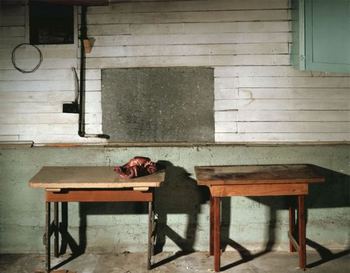 In a spare and bleak room, it’s an untidy knot of formerly organic matter grown dried and leathery, like a baseball glove forgotten in the back of a closet. It evokes the disarray of abandonment, not to the thrill of a species-to-species encounter.
In a spare and bleak room, it’s an untidy knot of formerly organic matter grown dried and leathery, like a baseball glove forgotten in the back of a closet. It evokes the disarray of abandonment, not to the thrill of a species-to-species encounter.
In the Western world, octopi live in fantasy as monsters. In the East, they are monsters on a mission. (Hokusai; not safe for work.)
Masami Teraoka (also not safe for work) added condoms. His are comic emblems of the orgasmic. Woody Allen once said that sex was the most fun he ever had without laughing. Teraoka’s fetishists of the sea bring these pleasurable opposites together.
Daikichi Amano – If a little is good, more is better.
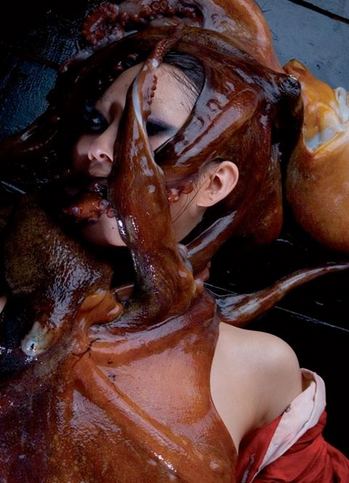 Also hitting that Japanese fish & sex note is Hajime Sorayama.
Also hitting that Japanese fish & sex note is Hajime Sorayama.
Lastly, for the carny touch: Germs4u.
Lisa Kereszi – street sign
Jonathan Borofsky – from drone to party animal
On the road to the Nome King in Frank Baum’s Ozma of Oz, an obscure sequel to the Wizard of Oz, Dorothy happens upon a Hammering Man.
The iron giant is a fine fellow,’ said Tiktok, ‘and works as steadily as a clock. He was made for the Nome King by Smith & Tinker, who made me, and his duty is to keep folks from finding the underground palace. Is he not a great work of art?’
Jonathan Borosky’s working stiff continues to hammer, which can’t be said of those it so ambiguously represents. Besides the one in front of the Seattle Art Museum, which at 48 feet is the largest in the series after one in Frankurt, Borosky’s men – nearly a dozen strong – pound out silent and unchanging beats in NYC, Minneapolis, Los Angeles, Basel, Seoul, and Washington, D.C.
In Seattle at least, the big man is hit. Against the
backdrop of Robert Venturi’s facade, which was partially inspired by
Chinese restaurants, it holds its place: Venturi’s complex elegance
vrs. Borosky’s droning mechanics.
Even so, I prefer its colorful kin. They’re short, but they know how party and wouldn’t consider pounding away at nothing for the duration of their unnatural lives.
(Image via.
Click to enlarge.)



